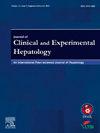代谢功能障碍相关性脂肪性肝病患者的风险分层:脂肪性肝炎、纤维化和肝细胞癌
IF 3.2
Q2 GASTROENTEROLOGY & HEPATOLOGY
Journal of Clinical and Experimental Hepatology
Pub Date : 2024-09-20
DOI:10.1016/j.jceh.2024.102415
引用次数: 0
摘要
代谢功能障碍相关性脂肪性肝病(MASLD),以前被称为非酒精性脂肪肝(NAFLD),在全球范围内呈上升趋势,引起了越来越多的公众健康关注。中心性肥胖、血脂异常、高血压和高血糖等代谢紊乱与脂肪肝密切相关。晚期肝纤维化是发病、肝脏相关并发症和死亡的主要预测因素。各种无创评分系统被用于对普通人群进行可接受的筛查和诊断 MASLD 患者。遗憾的是,到目前为止,还没有一种诊断测试被认为足以可靠地诊断和监测 MASLD 患者。肝活检仍是诊断代谢功能障碍相关性脂肪性肝炎(MASH)(伴有或不伴有纤维化)的金标准,影响着MASLD患者的预后和生存。鉴别有患 MASH、肝纤维化和 HCC 风险的患者更具挑战性;利用现有非侵入性方法达到这些目的的证据有限。本综述讨论了对 MASLD 患者进行风险分层的工具和步骤,提供了指导使用各种诊断和评分工具的数据,重点介绍了无创检测有罹患 MASH、纤维化和 HCC 风险的患者的最新技术。本文章由计算机程序翻译,如有差异,请以英文原文为准。
Risk Stratification of Patients with Metabolic Dysfunction-associated Steatotic Liver Disease: Steatohepatitis, Fibrosis, and Hepatocellular Carcinoma
The metabolic dysfunction-associated steatotic liver disease (MASLD), formerly known as nonalcoholic fatty liver disease (NAFLD), is increasing globally, creating a growing public health concern. Metabolic disorders such as central obesity, dyslipidemia, hypertension, and hyperglycemia are intimately related to MASLD. Advanced hepatic fibrosis is the main predictor of morbidity, liver-related complications, and deaths. Various noninvasive scoring systems are used to practice acceptable general population screening and diagnose patients with MASLD. Unfortunately, as of right now, no single diagnostic test is thought to be reliable enough to diagnose and monitor MASLD patients. Liver biopsy remains the gold standard for diagnosing metabolic dysfunction-associated steatohepatitis (MASH) (with or without fibrosis), impacting the prognosis and survival of patients with MASLD.
Moreover, it is anticipated that MASLD is a risk factor for hepatocellular carcinoma (HCC) development, and several risk factors for MASLD occurrence are also linked to the development of HCC. Identifying patients with a risk of developing MASH, fibrosis, and HCC is more challenging; there is limited evidence on utilizing available noninvasive methods for these purposes. This review discusses the tools and steps of risk stratification in MASLD patients, providing data to guide the utilization of various diagnostic and scoring tools, focusing on the latest techniques to non-invasively detect patients at risk of developing MASH, fibrosis, and HCC.
求助全文
通过发布文献求助,成功后即可免费获取论文全文。
去求助
来源期刊

Journal of Clinical and Experimental Hepatology
GASTROENTEROLOGY & HEPATOLOGY-
CiteScore
4.90
自引率
16.70%
发文量
537
审稿时长
64 days
 求助内容:
求助内容: 应助结果提醒方式:
应助结果提醒方式:


